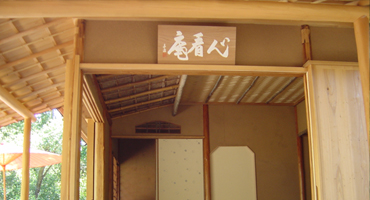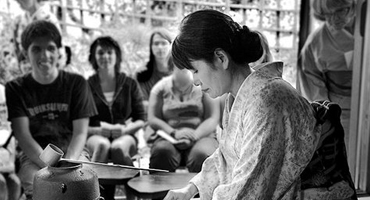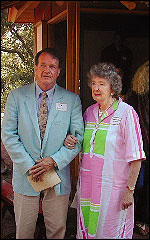About Us

Chanoyu of Santa Barbara
Welcome to Chanoyu of Santa Barbara. We are currently a group under the instruction of Mrs. Sokyo Kasai, learning the Urasenke traditional way of tea ceremony also called Chanoyu (the way of tea). We appreciate your interest and welcome you. We invite you to learn more about our instructor, our teahouse and the ongoing classes held in the Santa Barbara and Solvang area. Shinkanan Tea group is a member of the Urasenke Tankokai LA Association. We practice Urasenke Tradition of Tea under the direction of Sokyo Kasai, first degree certified instructor (Kyojyu). Class is open for all levels. Tankokai Membership fees may vary. Please check www.urasenkela.org

Sensei Sokyo Kasai
Over the past twenty years, Mrs. Sokyo Kasai has given tea ceremony demonstrations and lectures at UCSB, the Santa Barbara Museum of Art, the Ikenobo Studio of Heartie Anne Look, Antioch University, Santa Barbara City College, Samarkand Retirement Community, and at various churches, private parties and service organizations. Since her childhood long study of Urasenke Traditional Japanese Art of Tea, in 2003~2004 she has completed a 6-month Intensive Course Study at Urasenke Gakuen (Chado Urasenke School Way Of Tea) in Kyoto, Japan . She is currently teaching our group in Santa Barbara California, as a Kyojyu(Professor), holding regular private classes for all levels at her residence in Solvang and in the teahouse called Shin Kan An (Look through the Heart), located within the Santa Barbara Botanic Garden.

Shin Kan An
This teahouse was built in 1949, by skilled craftsmen in Kyoto, Japan, and then shipped to California as a gift for retired businessman Royce Greatwood. The teahouse was reassembled in the Greatwood’s Hope Ranch lemon orchard. In 1958, the home and orchard became the property of the John H. Esbenshade family. In 1998, with the help of the Santa Barbara-Toba Sister City Organization, the Esbenshades donated this unique teahouse to the Santa Barbara Botanic Garden, where it is being preserved and appreciated by visitors in this beautiful naturalistic setting. The rich cultural tradition of Cha-do (Japanese tea culture), graces this teahouse. It was given the name Shin Kan An, meaning, “ Look Through the Heart,” by the 15th generation Hounsai Oiemoto (now Hounsai Genshitsu Daisosho) of the Urasenke Tea School. The name was generously given in honor of Heartie Anne Look, a teacher of Ikenobo Flower Arrangement and Japanese culture for many years in the Santa Barbara community. Shin Kan An, is currently used for authentic Chanoyu tea ceremony events and classes.




